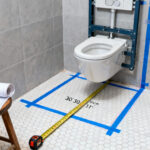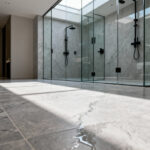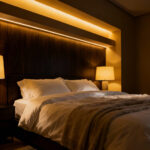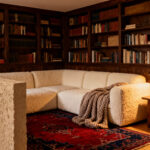Can we just talk for a minute about why everyone gets brown kitchens wrong? People hear “brown kitchen” and they immediately picture their grandma’s 1978 kitchen with the dark, heavy cabinets that sucked all the joy and light out of the room. They think it’s a one-way ticket to a dark, dated cave. And they’re not entirely wrong—if you do it badly.
But that’s the thing. It’s not the brown that’s the problem. It’s the execution. A brilliantly designed brown kitchen feels grounded, warm, sophisticated, and absolutely timeless. The secret isn’t in finding one “perfect” shade of brown. The secret is in understanding light, texture, and layering. As an architectural lighting designer, I’ve seen beautiful brown kitchens come alive and horrifically dark ones die on the vine, and the difference almost always comes down to these details. Forget the corporate blog posts. Let me show you what actually matters.
Starting with Brown: Vision & Palette
Look, before you even think about a single cabinet door or paint chip, we need to talk strategy. This is the part everyone wants to skip because it feels like homework, but I’m telling you, this is where you save yourself from a kitchen that feels ‘off’ and you can’t put your finger on why. It all starts with a clear vision and understanding the temperature of your colors.
1. Defining Your Desired Brown Kitchen Aesthetic Clearly
This sounds like fluffy designer-speak, but it’s the most brutally practical step. You need a blueprint. A mission statement for your kitchen. I watched a client lose thousands on restocking fees for cabinets they “loved” in the showroom because they never clearly defined their aesthetic. They just picked things they liked individually, and when assembled, the “rustic” floor fought with the “modern” cabinets and the “transitional” light fixtures. It was a mess.
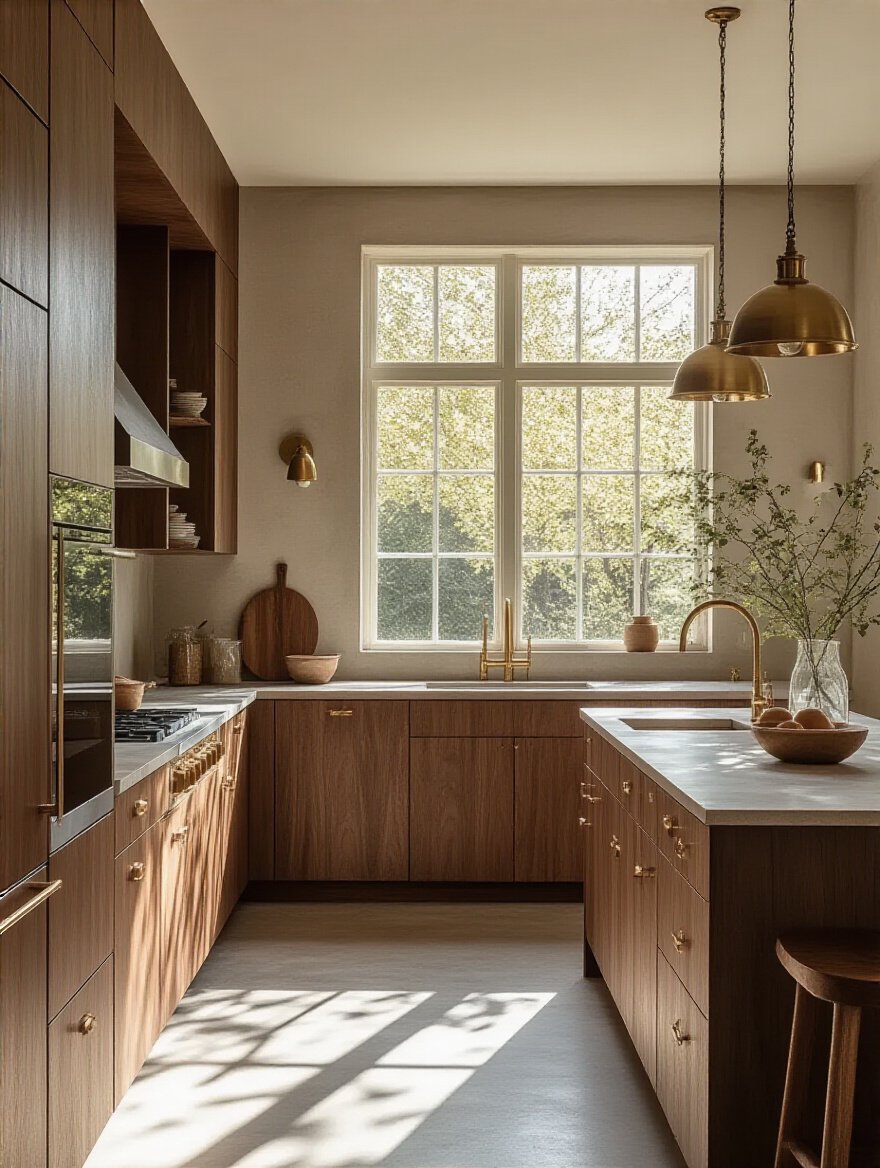
Your blueprint isn’t just a Pinterest board of random brown kitchens; it’s a document where you decide: are we going for warm and cozy farmhouse, or sleek and sophisticated modern? Write it down. Find five inspiration images that all fit that specific vibe. This document is your North Star. It’s what you’ll hold your tile, hardware, and lighting choices up against and ask, “Does this serve the mission?” This simple discipline is the difference between a cohesive, expensive-looking kitchen and a collection of expensive mistakes.
Once you have that north star, we can start layering in the actual shades of brown.
2. Blending Diverse Brown Shades for Layered Depth
The biggest mistake people make with a brown kitchen is picking one brown and slapping it everywhere. The cabinets, the island, the floor… it becomes a flat, monolithic sea of brown. That’s what creates the dreaded “brown cave” effect. The real magic comes from layering. Think about a forest; it’s not one shade of brown. It’s a hundred, from the dark, damp soil to the pale, silvery bark.

You don’t need a hundred shades, but you need at least three. A dominant, mid-tone brown for the bulk of the cabinetry is a great starting point. Then, bring in something darker to anchor the space—maybe on the island or the lower cabinets. And finally, something lighter to lift it, like light oak open shelves or a warm, beigey countertop. The key is to make sure their undertones play nicely together. Stick to all warm-undertone browns, or all cool-undertone browns. This layering is what gives a room that rich, complex, “designed” feel.
From here, it’s about choosing which family of brown you want to live with: the cozy, warm ones, or the sophisticated, cool ones.
3. Choosing Warm Brown Hues for Cozy Kitchen Ambiance
Warm browns are the ones with red, orange, or yellow undertones. Think honey oak, rich cherry, walnut, or terracotta. These are the colors that inherently feel like a hug. They’re comforting, welcoming, and create that “heart of the home” vibe effortlessly. If your goal is a kitchen where everyone gathers, where it feels warm even on a cloudy day, this is your palette.
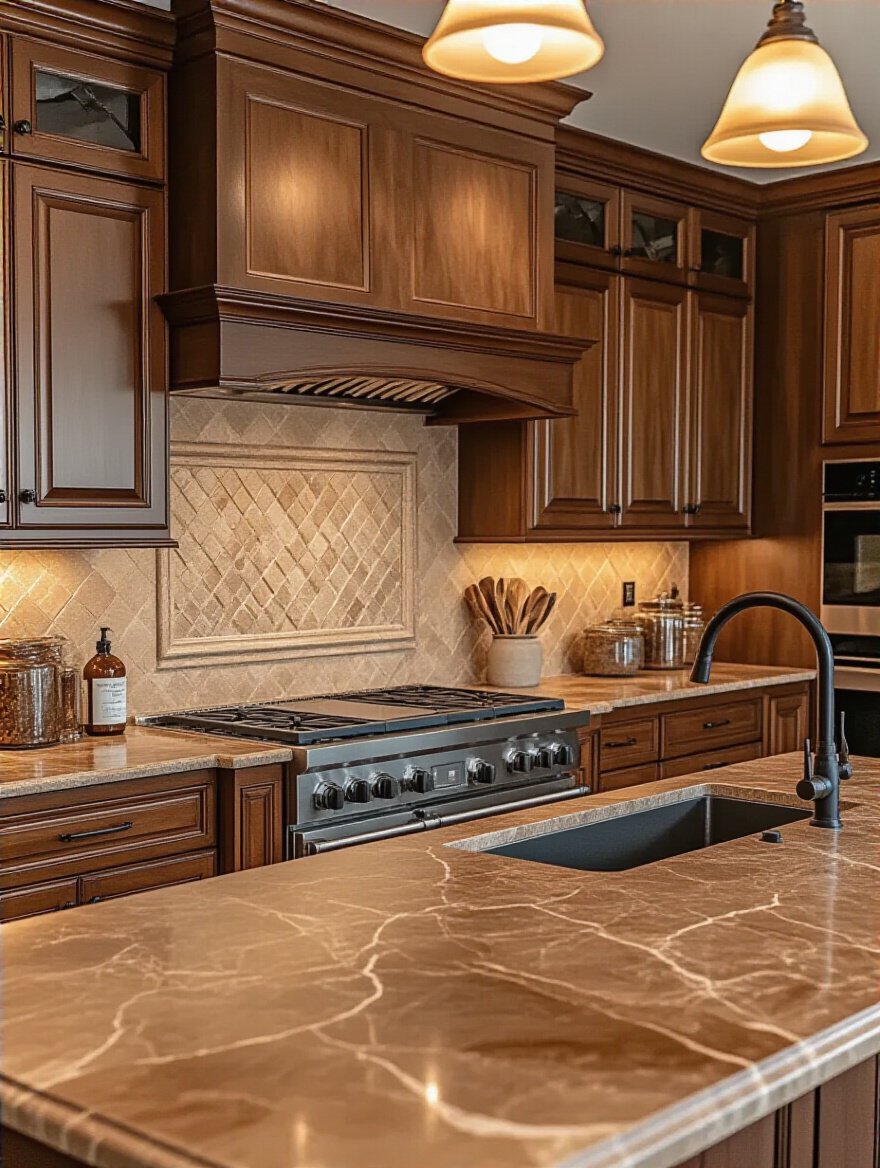
But here’s the technical bit most people miss: warm browns come alive under warm light. You need to match your light bulbs to your browns. We’re talking a color temperature of 2700K to 3000K (Kelvin). This is the warm, golden-hour glow you see in high-end restaurants and hotels. If you put a cool, blue-ish 4000K bulb in a warm brown kitchen, the light will fight the wood tones, making them look dull, flat, and sometimes even a sickly green. So, when you choose warm browns, you’re also choosing warm lighting. They’re a package deal.
Now, if you’re aiming for something more modern and less “cozy farmhouse,” let’s talk about brown’s sophisticated cousin.
4. Selecting Cooler Browns for Modern, Sophisticated Spaces
Cooler browns are the secret weapon for a modern, almost-minimalist space that still feels grounded and natural. These are the browns with gray, green, or taupe undertones. Think mushroom, greige, or dark espresso with an ashen tint. They feel more sophisticated, more architectural, and less overtly “cozy.” They pair beautifully with sharp, clean lines, concrete, and stainless steel.
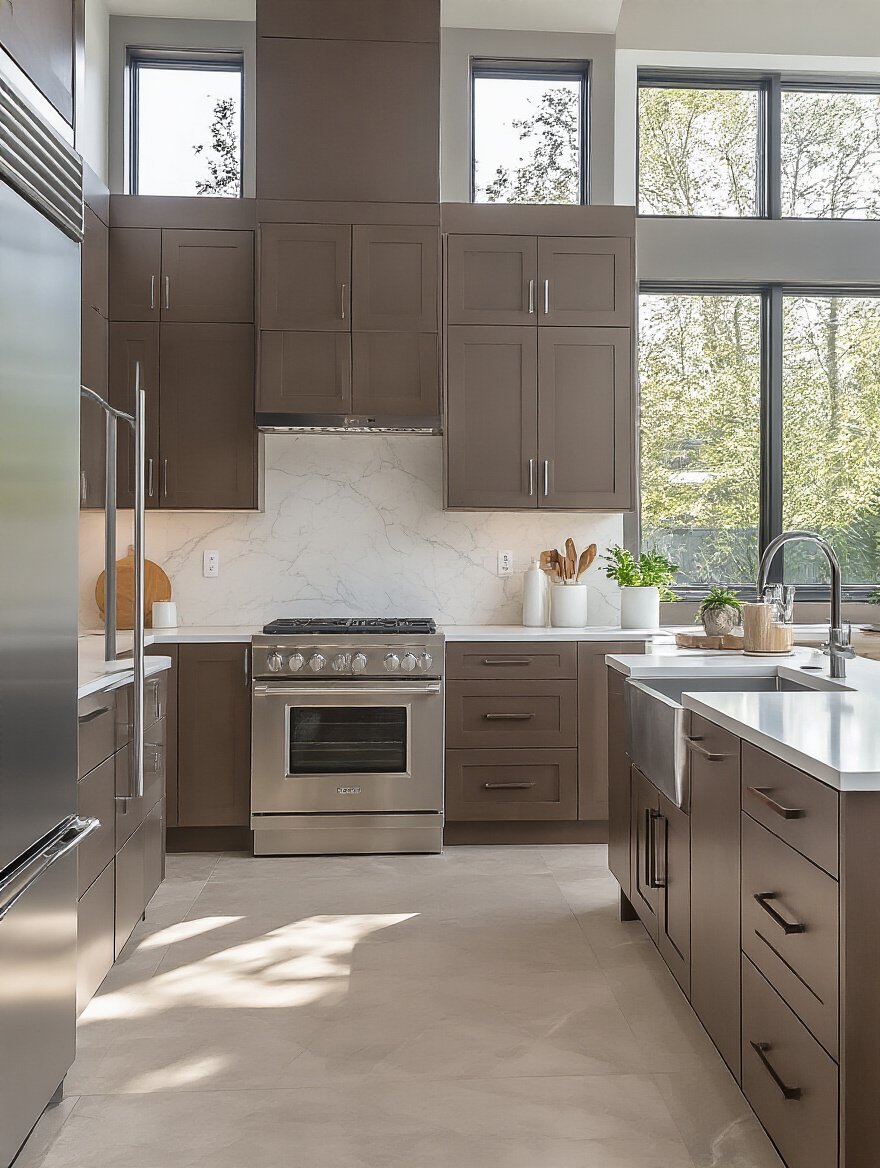
Here again, lighting is critical. These tones look incredible in bright, natural light or under a crisp, neutral white light around 3000K to 3500K. You want to render their cool undertones accurately, not warm them up with a yellow-toned bulb, which would just make them look muddy. I once had to fix a kitchen where the designer used a stunning cool taupe on the cabinets, but the homeowner had installed very warm 2700K bulbs. The entire kitchen looked kind of… sad. We swapped the bulbs to 3500K, and it was like a brand-new space. Suddenly it was chic, intentional, and sharp.
Whether you go warm or cool, the next step is the one that ties it all together.
5. Integrating Brown with Underlying Color Temperature Harmony
I can’t stress this enough: this is the secret sauce. Color harmony isn’t just about making sure your backsplash “goes with” your cabinets. It’s about ensuring the underlying temperature—warm or cool—is consistent across everything. This includes your wall paint, your countertops, your hardware, your floor, and especially your lighting. I’m telling you, the human eye can sense when temperatures clash, even if you don’t know why. It creates a subtle, jarring feeling that makes a space uncomfortable.
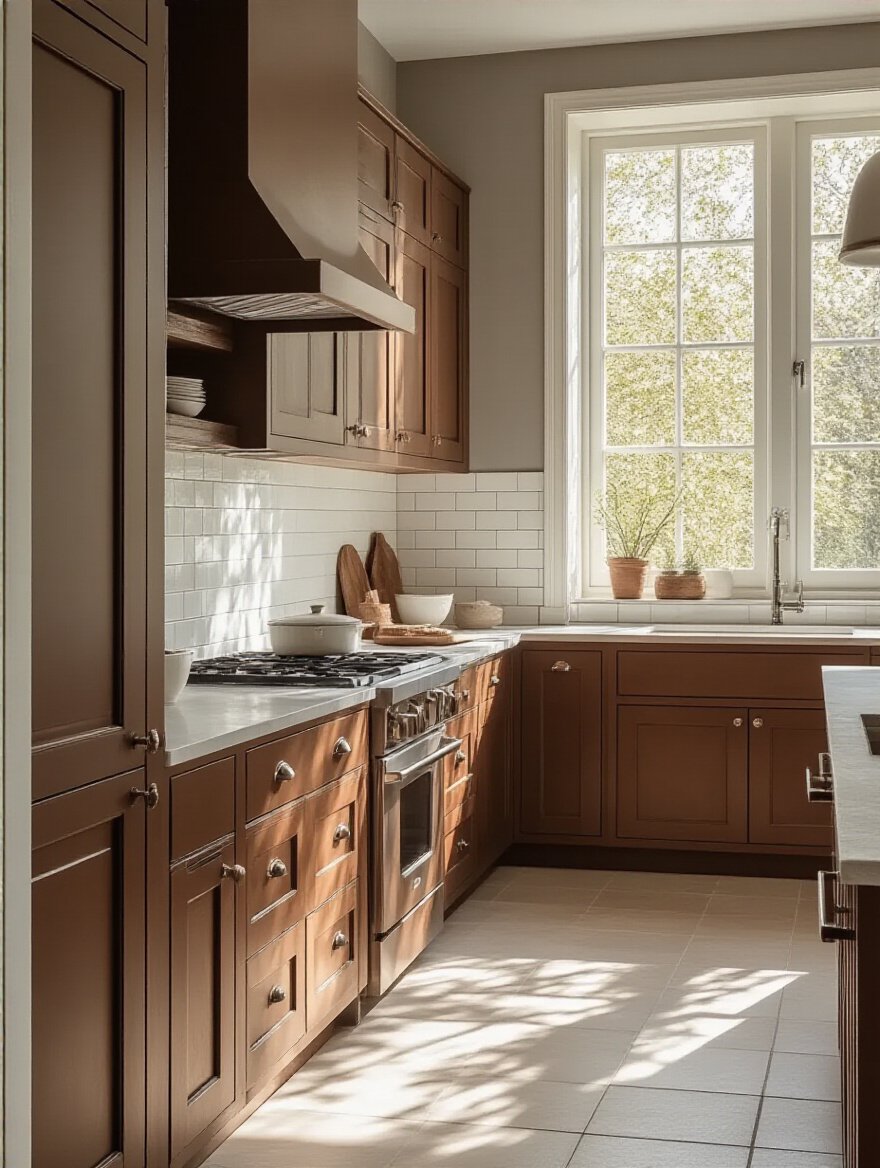
Here’s the shortcut I wish someone had told me years ago: take your primary brown sample (like a cabinet door) and hold it up next to all your other potential choices in your actual kitchen. Not in the showroom. See how they look in the morning light, in the afternoon, and under your current light bulbs. Does your “warm gray” paint suddenly look purple next to your cherry-brown cabinets? Good, you just saved yourself a costly mistake. And for the love of God, when you choose your light bulbs, get ones with a high Color Rendering Index (CRI) of 90+. A low CRI bulb can make even the most beautiful brown look cheap and off-color.
Primary Brown Elements: Surfaces & Cabinetry
Okay, with the strategy set, let’s get into the big stuff. These are the foundational elements that will do most of the talking. Getting these right is 80% of the battle.
6. Specifying Durable Brown Countertop Materials with Confidence
Your countertop is a workhorse, but it’s also a massive visual plane. For a brown kitchen, the material and finish you choose have a huge impact on light. A polished brown granite or quartz will bounce light around the room, creating highlights and making the space feel more alive. A matte or honed finish, on the other hand, will absorb light, creating a softer, more velvety, and moody feel. Neither is right or wrong, but it’s a deliberate choice.

When it comes to durability, the noise is the endless debate between natural stone and engineered stone. Here’s what matters: for most busy families, an engineered quartz or a sintered stone like Dekton is the smarter choice. They’re non-porous (so red wine spills aren’t a catastrophe) and incredibly scratch-resistant. If you want to go with natural brown granite, look for something with a bit of movement or flecking in it. A solid, uniform dark brown shows every single crumb and fingerprint. The subtle pattern in something like ‘Baltic Brown’ granite is your best friend for hiding daily life.
From the horizontal plane, we move to the vertical—the cabinets that define the room’s character.
7. Selecting the Perfect Brown Cabinet Finish and Wood Type
The choice between, say, a warm walnut and a light rift-sawn oak is a choice about character. Walnut feels mid-century, sophisticated, and rich. Oak, especially in a lighter stain, feels more modern, airy, and a bit Scandinavian. The wood species determines the grain pattern, and the stain determines the color. Always, always, always get a sample door. A tiny 2×2 inch swatch is useless. You need to see how the grain moves across a larger surface.
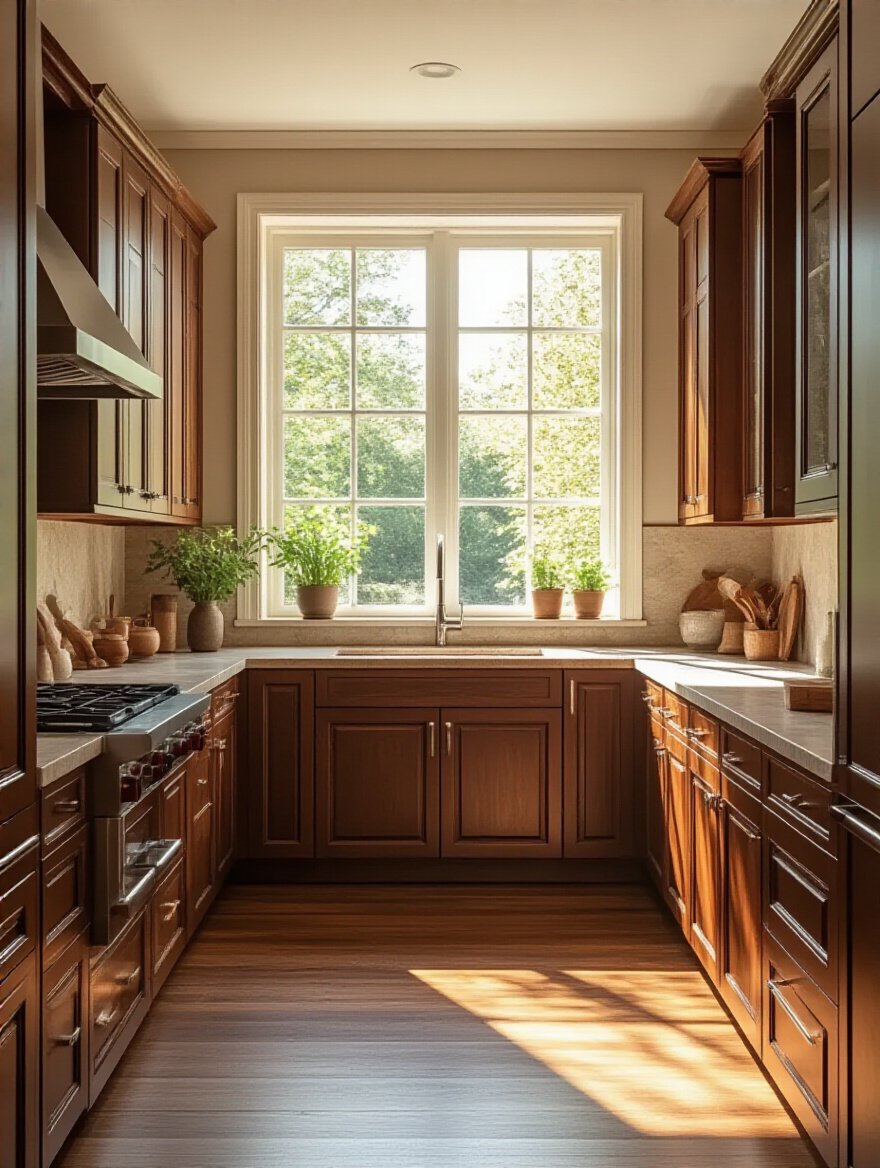
The finish—matte, satin, or gloss—is your light-management tool. A high-gloss finish will bounce light around like crazy, which can be great in a small, dark kitchen. But it also shows every fingerprint. A matte finish is the opposite; it diffuses light for a soft, uniform look and is much more forgiving. For most people, a satin finish is the perfect middle ground. It has a subtle sheen that’s easy to clean but won’t cause distracting glare under your kitchen lights.
Next, we look down to the element that grounds the entire space.
8. Incorporating Rich Brown Flooring for Grounding Appeal
Your floor is the anchor. A rich, medium-to-dark brown floor provides a solid, grounding foundation that makes everything else on top of it feel more intentional. It’s especially powerful if you’re using lighter cabinets, as the contrast creates a beautiful balance. A dark floor under light cabinets makes the room feel stable and keeps the lighter elements from feeling like they’re floating away.
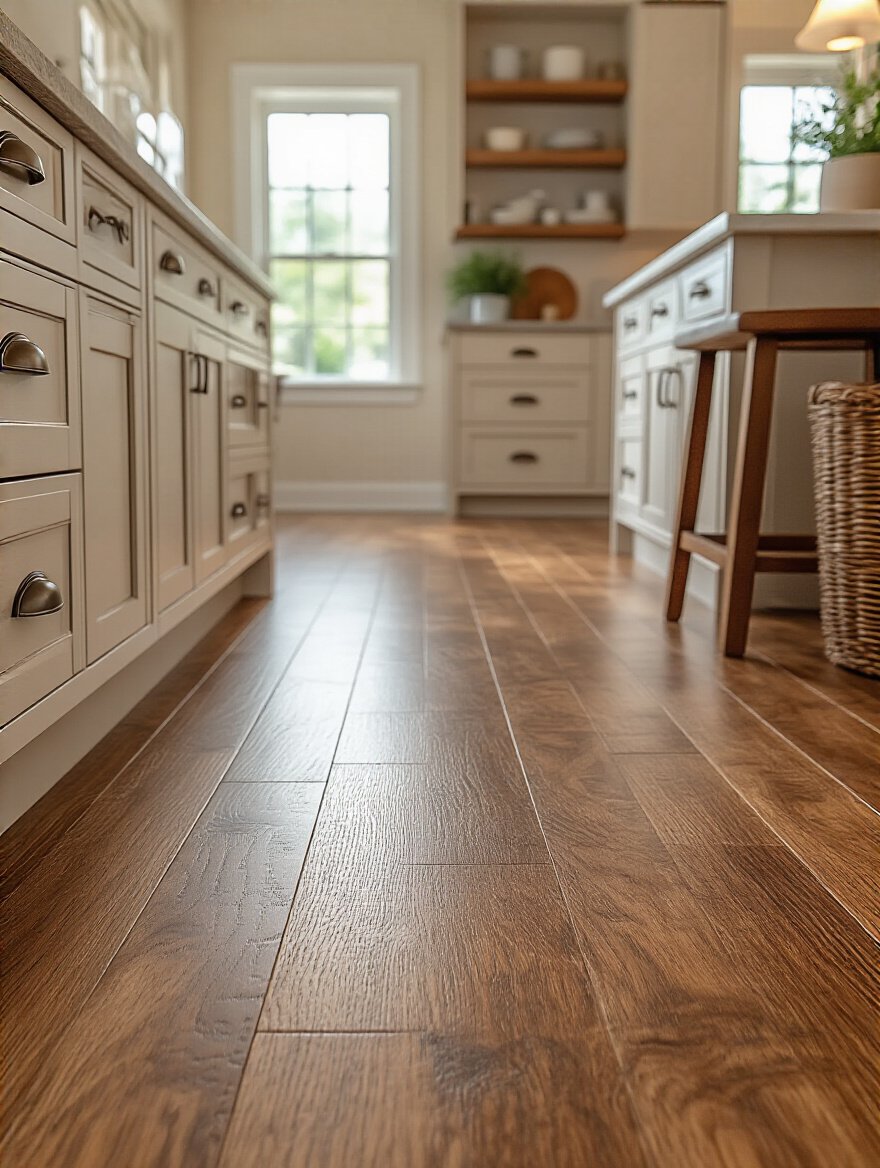
Everyone gets obsessed with hardwood, and it’s beautiful, but don’t sleep on Luxury Vinyl Tile (LVT). I just worked on a project for a family with two big dogs and three kids. They wanted the look of dark walnut floors but knew hardwood would get destroyed. We used a high-end LVT that looked incredibly realistic, was 100% waterproof, and is basically bomb-proof. It grounded their creamy white and brown-island kitchen perfectly without the maintenance headache. The point is to create that visual weight at the bottom of the room, regardless of the material.
Now for the ‘jewelry’ of the kitchen walls.
9. Designing Brown Backsplashes with Strategic Material Mixes
The backsplash is your opportunity to play with texture and light on a smaller scale. If you have matte brown cabinets, a glossy backsplash tile can provide a beautiful pop of contrast and help bounce your under-cabinet task lighting onto the counters where you need it. Think of the backsplash as a functional light reflector.

A client of mine had beautiful, flat-paneled walnut cabinets and wanted to keep the look modern. Instead of a typical tile, we used a single slab of the same quartzite from their island for the backsplash. The stone had subtle brown and cream veining, and its polished surface reflected the light and the view out the window, adding incredible depth and making the whole wall feel like a piece of art. The BS to avoid here is thinking it has to be a busy mosaic. Often, the simplest choice—a textured Zellige tile in a single creamy color or a continuous slab—is the most powerful against a rich brown.
Now, let’s talk about making things disappear for a cleaner look.
10. Maximizing Storage with Brown Integrated Appliance Panels
Nothing chops up the beautiful, clean lines of a brown kitchen faster than a big slab of stainless steel. Your refrigerator, your dishwasher… they create visual noise. This is where integrated panels are a game-changer. By facing your appliances with the same material as your cabinets, you create a seamless, uninterrupted wall of beautiful brown. The kitchen instantly feels bigger, calmer, and more high-end.

I used to think this was an unnecessary luxury. Then I designed the lighting for a small galley kitchen in a condo. The owner opted for integrated panels on his fridge and dishwasher. The effect was astonishing. By eliminating the visual break of the appliances, the single, continuous wall of warm brown wood made the narrow space feel a good two feet wider. It’s a trick of the eye, but it works. This is what you do when you want the brown tones to be the star, not the brand of your dishwasher.
Accentuating Brown: Metals, Lighting & Details
You’ve built the foundation. Now comes the fun part. These are the accent pieces that act like jewelry for your kitchen, adding sparkle, contrast, and personality. This is how you take a “nice” brown kitchen and make it “wow.”
11. Elevating Brown with Polished Brass or Copper Hardware
Against a deep, rich brown, polished brass or copper hardware isn’t just hardware; it’s a source of light. In lighting design, we call these “specular highlights”—tiny, brilliant points of reflection that catch your eye. They sparkle under both daylight and artificial light, adding a layer of warmth and luxury that pewter or brushed nickel just can’t match.

I’ll tell you what’s just noise: worrying about whether it’s “too trendy.” Warm metals have been used for centuries for a reason. They feel good. They feel rich. I advised a client with a dark espresso-brown kitchen to swap their boring silver knobs for unlacquered brass pulls. It was a tiny change that cost a few hundred dollars, and it completely transformed the feel of the room from sterile to stately. The brass will develop a natural patina over time, adding even more character. It’s a classic pairing that just works.
Hardware is a point of light, but now let’s talk about the real sources.
12. Brightening Brown Kitchens Using Layered Lighting Strategies
This is my entire job, so listen up. You cannot have a successful brown kitchen without a layered lighting plan. Period. You need three layers, and they must be on separate, dimmable circuits. First, Ambient light: this is your general, overhead illumination from recessed cans or a central fixture. It fills the room. Aim for a warm 3000K. Second, Task light: this is the most important layer. It’s the light that illuminates your work surfaces. Under-cabinet LED strips are non-negotiable. They eliminate shadows from the upper cabinets and make the kitchen ten times more functional. This can be a slightly cooler, crisper 3500K for clarity.
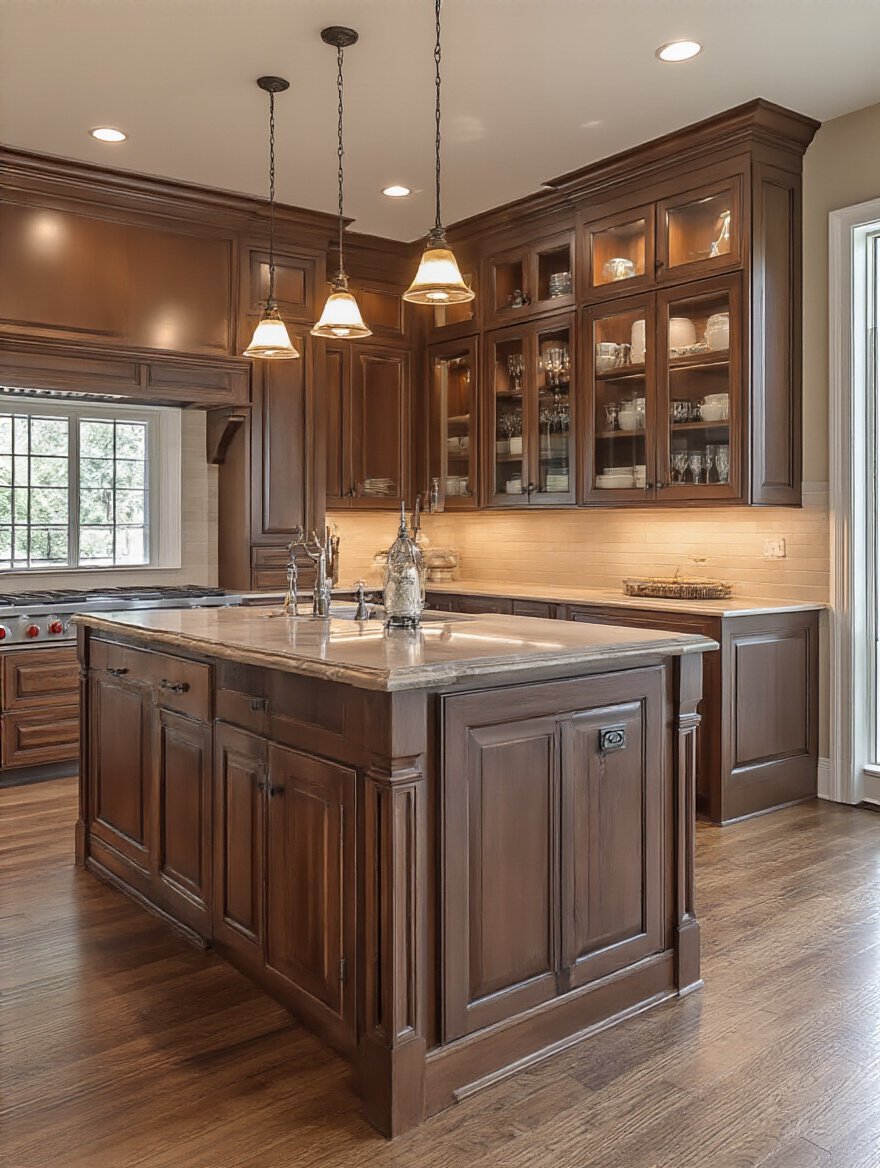
Third, Accent light: this is the magic. It’s a spotlight on your open shelves, a beautiful pendant over the island, or even LED strips inside a glass cabinet. It creates mood, highlights features, and makes the kitchen feel special. I once saved a “dark and depressing” walnut kitchen simply by adding dimmable under-cabinet and in-cabinet lighting. The owner was ready to rip it all out. Instead, for a fraction of the cost, we gave it depth, mood, and function. The brown wasn’t the problem; the single, terrible overhead light was. Dimmers are not a suggestion; they are a requirement for all three layers.
From the sparkle of light, let’s talk about the sophistication of darkness.
13. Choosing Dark Metal Fixtures for Industrial Brown Contrast
If brass is the jewelry, matte black or oil-rubbed bronze is the perfect black turtleneck. It’s sophisticated, grounding, and creates a powerful contrast against warm or medium-toned browns. Matte black, in particular, absorbs light, which makes it feel solid and architectural. Using black for a faucet, pendant light fixtures, or hardware creates strong anchor points that keep a brown kitchen from feeling too soft or traditional.

The trick is to use it with intention. A matte black gooseneck faucet against a light countertop with brown cabinets in the background becomes a sculptural element. Black metal-framed pendant lights over an island define that zone. A client of mine paired medium-toned oak cabinets with a matte black range hood and black hardware. The result was a stunning blend of rustic and industrial that felt both modern and timeless. It’s the perfect way to add a bit of edge and stop a brown kitchen from feeling too safe.
Next up, how to make your kitchen feel bigger without moving a single wall.
14. Integrating Reflective Surfaces to Expand Brown Spaces
Brown, especially dark brown, absorbs light. To counteract this, you need to strategically inject surfaces that bounce light back into the room. This isn’t just about hanging a mirror (though that can work!). It’s about thinking of every surface as a potential light-bouncing tool. A polished quartz countertop, a glossy ceramic backsplash, a high-sheen cabinet finish, or even polished chrome or brass hardware all serve to reflect light.

I worked on a narrow brown kitchen that only had one small window at the far end. It was a tunnel. We couldn’t add windows, so we did three things: installed a backsplash of antiqued mirror tile, chose a high-gloss finish for the upper cabinets, and used a polished finish on the light-colored countertop. The effect was immediate. The mirrored backsplash reflected the light from the window and the under-cabinet lighting, making the space feel twice as deep. The glossy uppers bounced light down from the ceiling. It’s basic physics, but it feels like magic.
Finally, a functional detail that can make or break your kitchen’s utility.
15. Designing Custom Brown Island Seating for Functionality
An island is the social hub of a Modern Kitchen. When it’s brown, it becomes a beautiful, warm piece of furniture. The design of the seating is paramount. The number one mistake I see is not leaving enough knee space. You need a bare minimum of 12 inches of overhang, but 15 is better if you want adults to sit there comfortably for more than five minutes.

The other key is lighting this zone properly. A series of two or three beautiful pendant lights over the island not only provides task lighting for the surface but also defines the seating area as its own “room” within the kitchen. Make sure the scale is right. Tiny pendants over a massive island look silly, and huge pendants over a small one are overwhelming. As a rule of thumb, the bottom of the pendant should hang 30-36 inches above the countertop. And yes, they absolutely need to be on a dimmer.
Beyond the Brown: Textiles, Greenery & Open Storage
Okay, we’ve handled the hard surfaces. Now we need to bring in softness, life, and personality. These are the elements that keep a brown kitchen from feeling like a sterile showroom and turn it into a home.
16. Softening Brown Interiors with Textured Fabrics and Rugs
Hard surfaces reflect sound and can make a kitchen feel loud and clattery. Fabrics and textures absorb sound and soften the whole experience. A simple runner rug in front of the sink, woven bar stool seats, or linen Roman shades on the window can make a massive difference. They add a tactile layer that invites you to touch and stay.

I love using texture to break up the visual monotony of a brown kitchen. Against smooth, flat-panel brown cabinets, a nubby, wool rug or a chunky-knit throw on a banquette adds so much warmth and visual interest. These soft elements also diffuse light in a beautiful way, contributing to a gentler, more inviting ambient glow rather than the harsh reflections you get off of hard, polished surfaces alone. It’s an easy way to add a layer of cozy without renovating.
Next, add some life. Literally.
17. Introducing Fresh Greenery and Natural Elements Visually
A brown kitchen is an earthy kitchen. What’s the most natural thing to pair with earth tones? Plants. The vibrant green of a fresh plant is the perfect complementary color to the rich tones of brown wood. It provides a pop of life and vitality that stops the room from feeling too staid or serious.

You don’t need to turn your kitchen into a jungle. A small pot of herbs on the windowsill, a trailing pothos on top of the cabinets, or a single, dramatic fiddle-leaf fig in a corner is enough. I often suggest clients put a small, hardy snake plant on a floating shelf. The strong vertical lines and deep green color look incredible against a warm wood backdrop. It’s an easy, inexpensive way to add color, texture, and a sculptural element that feels totally organic.
Now for a slightly controversial but powerful move.
18. Showcasing Cookware on Open Brown Shelving Creatively
I know, I know. People are afraid of open shelving because they think it will look messy. And it will, if you just throw junk on it. But if you curate it, open shelving can be a beautiful and functional feature, especially in a brown kitchen. It breaks up the visual weight of a solid wall of upper cabinets, making the room feel lighter and more open.

I’m a huge fan of using thick, floating brown shelves—perhaps in a slightly lighter or darker tone than the main cabinets—to display everyday items that are also beautiful. A neat stack of your white ceramic plates, a collection of copper mugs, a few nice cookbooks. Here’s a pro lighting tip: install a hidden LED strip at the front inside edge of the shelf, washing light down the wall behind the objects. It turns your simple shelves into a brilliantly lit art feature.
To take that idea of wood to the next level…
19. Incorporating Rustic Wood Beams or Accents Thoughtfully
If you want to add instant character and architectural soul to a brown kitchen, rustic wood beams are the answer. They add texture, a sense of history, and draw the eye upward, making the ceiling feel higher. In a kitchen with sleek, modern brown cabinets, a few old, rough-hewn beams provide an incredible textural contrast.

A project I worked on had 10-foot ceilings in an open-concept space. The homeowner wanted a modern brown kitchen, but worried it would feel cold. We added three large, non-structural faux-wood beams across the ceiling. Then, we used track lighting between the beams to wash light onto the cabinet faces and provide task lighting. The beams not only added immense warmth and character but also gave us a perfect, discreet place to hide the functional lighting. They defined the kitchen space without building walls.
Refining Your Brown Kitchen: Personalization & Flow
We’re in the home stretch. This is about the fine-tuning that makes the kitchen yours, and makes it work with the rest of your home. A kitchen doesn’t exist in a vacuum.
20. Optimizing Kitchen Layouts for Brown Furniture Placement
How your kitchen is laid out matters immensely, especially with the visual weight of brown. The classic “work triangle” (sink, stove, fridge) is still a valid concept for efficiency. But now, with open-concept living, you also have to think about sightlines and flow. When you’re standing in the living room, what do you see in the kitchen? Place your most beautiful brown element—like a stunning walnut island—in that primary sightline.

On the other hand, try to keep the messiest parts of the kitchen (like the sink full of dishes) slightly obscured from the main living area if you can. A client of mine had a long island, and we designed it with the sink and dishwasher at the far end, away from the living room entrance, and the beautiful waterfall countertop and clean seating area at the near end. It brilliantly hides the daily chaos while showcasing the beautiful brown furniture piece that the island has become.
Beyond the big pieces, the smallest personal touches can have the biggest impact.
21. Personalizing Your Brown Kitchen with Unique Artwork
Please, don’t let your kitchen be the one room in the house with no art. Art is what injects your soul into a space. Against a backdrop of sophisticated brown, a piece of artwork can truly sing. You have this beautiful, neutral-but-warm canvas, so you can go bold. A vibrant abstract painting, a series of black-and-white photographs, or even a collection of ceramic plates can become a stunning focal point.

A fantastic shortcut is to use art to introduce a contrasting color. In a very warm, walnut-and-cream kitchen, a large piece of art with deep blues and greens can provide a cool, calming counterpoint that feels incredibly sophisticated. Just make sure to protect it. A print behind glass or a sealed canvas is a must in a kitchen environment to guard against grease and moisture. Hang it somewhere that won’t get direct splashes, like on the wall by a breakfast nook or at the end of a cabinet run.
And finally, let’s tie it all together.
22. Ensuring Seamless Flow into Adjoining Living Spaces
Your gorgeous brown kitchen needs to feel connected to the rest of your home, not like it was dropped in from another planet. The key to seamless flow is creating visual echoes. This doesn’t mean you need a brown sofa. It’s more subtle. Use the same flooring material throughout the kitchen and living space to erase the boundary. Pick a wall color for the living room that pulls one of the subtle undertones from your kitchen’s brown cabinets or countertops.

My favorite trick is to repeat metals and lighting temperature. If you used brushed brass hardware in the kitchen, use a brass floor lamp in the living room. Most importantly, ensure your lighting has a consistent color temperature. If your kitchen glows with a warm 3000K, your living room should too. This single, consistent layer of light is what stitches disparate spaces together into one cohesive, inviting home. When the light feels the same, the space feels the same.
The Takeaway
So, let’s be clear: brown isn’t dated. Boring, uninspired, poorly-lit design is dated. Brown is a timeless, versatile, and deeply comforting foundation for the heart of your home. It’s about understanding that a kitchen is more than a collection of finishes—it’s an experience built from layers of color, texture, and most importantly, light. It’s about the soft glow from under a cabinet that makes your countertops usable and beautiful, the sparkle of brass hardware, and the way a rich wood grain feels solid and grounding under your hands.
Don’t be afraid of the dark. Embrace it, then light it beautifully. When you do, you’re not just creating a brown kitchen; you’re creating a space that feels like home, for decades to come.

